统计数值预报产品生成时间:重采样
目录
之前的文章《统计数值天气预报模式产品生成的典型时间》中介绍根据GRIB2文件创建时间统计产品生成的典型时间,并在《统计数值预报产品生成时间:单个时效重采样》中介绍使用重采样技术统计单个时效的生成时间。
本文基于这两篇文章,介绍如何使用自助法统计 所有 时效产品的生成时间。
声明:本文仅代表作者个人观点,所用数据无法代表真实情况,严禁转载。关于模式系统的相关信息,请以官方发布的信息及经过同行评议的论文为准。
数据
载入需要使用的库
from pathlib import Path
import pandas as pd
import numpy as np
import matplotlib.pyplot as plt
from nwpc_data.data_finder import find_local_file构造一个函数,批量获取文件创建时间
def calculate_time(
data_type,
date_range,
forecast_hours,
):
b = []
for forecast_hour in forecast_hours:
file_list=[
find_local_file(
data_type,
start_time=t,
forecast_time=forecast_hour
)
for t
in date_range
]
ts = [pd.to_datetime(Path(f).stat().st_mtime_ns) - pd.to_datetime(d.date()) for f, d in zip(file_list, date_range) ]
s = pd.Series(ts, index=date_range)
s.name = int(forecast_hour.seconds/3600) + forecast_hour.days * 24
b.append(s)
df = pd.DataFrame(b)
df = df.T
return df构造起报时次列表
date_range = pd.date_range(
"2020-03-01 00:00:00",
"2020-04-29 00:00:00",
freq="D"
)构造时效列表
forecast_hours = [
pd.Timedelta(hours=h)
for h in
np.append(
np.arange(0, 121, 3),
np.arange(126, 241, 6)
)
]计算时间段内所有时效文件的创建时间
df = calculate_time(
"grapes_gfs_gmf/grib2/orig",
date_range,
forecast_hours
)
df.head()
重采样
对数据进行重采样,每次选择 20 个样本,重复 10000 次。 计算每次采样的均值。
注意:本文采样单位是 df 中的一行,即同一个时次各个时效的生成时间。
count = 10000
means = []
for i in range(0, count):
sampled_data = df.sample(n=20, replace=True)
means.append(sampled_data.mean())
bdf = pd.DataFrame(means).applymap(lambda x: x.ceil("s"))
bdf.head()
计算重采样数据的统计量
stat_df = pd.DataFrame(
{
"bdf_median": bdf.median(),
"bdf_mean": bdf.mean(),
"bdf_1/4": bdf.quantile(.25, numeric_only=False, interpolation="nearest"),
"bdf_3/4": bdf.quantile(.75, numeric_only=False, interpolation="nearest"),
"bdf_0.95": bdf.quantile(.95, numeric_only=False, interpolation="nearest"),
}
)
stat_df = stat_df.applymap(lambda x: x.ceil("S"))
stat_df.head()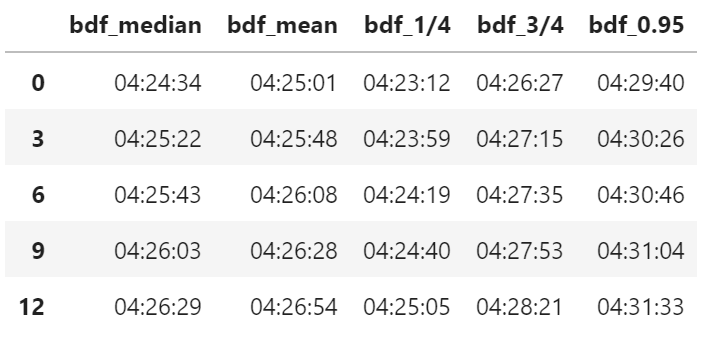
绘图
使用 Bokeh 绘制上面的统计量
from bokeh.io import output_notebook, show
from bokeh.plotting import figure
output_notebook()
from bokeh.models.formatters import DatetimeTickFormatter
data = stat_df
p = figure(
plot_width=1000,
plot_height=600,
y_axis_type="datetime",
title="MODEL A GRIB2 ORIG",
)
p.yaxis.formatter = DatetimeTickFormatter(
minsec=['%H:%M:%S'],
minutes=['%H:%M:%S'],
hourmin=['%H:%M:%S'],
hours=['%H:%M:%S']
)
p.line(
data.index,
data['bdf_mean'],
line_color="SkyBlue",
legend_label="bdf_mean",
)
p.line(
data.index,
data['bdf_1/4'],
line_color="Pink",
legend_label="bdf_1/4",
)
p.line(
data.index,
data['bdf_median'],
line_color="green",
legend_label="bdf_1/2",
)
p.line(
data.index,
data['bdf_3/4'],
line_color="Purple",
legend_label="bdf_3/4",
)
p.line(
data.index,
data['bdf_0.95'],
line_color="Salmon",
legend_label="bdf_0.95",
)
p.xaxis.axis_label = "forecast hour"
p.yaxis.axis_label = "clock"
p.legend.location = "top_left"
show(p)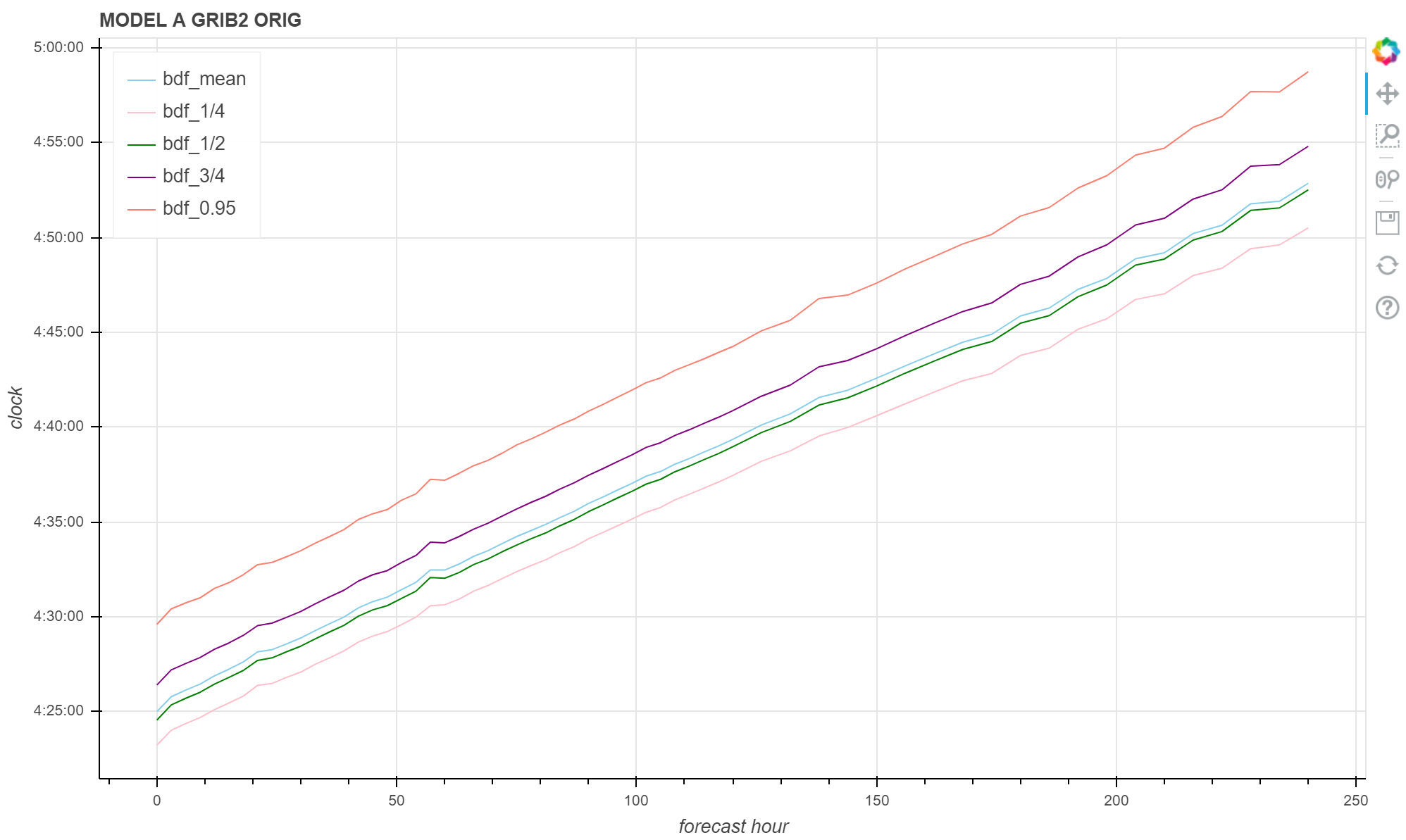
可以看到重采样后的数据无论是均值、中位数、四分位数还是 95% 分位点都保持基本相同的趋势。
数据分布
使用 Seaborn 绘制箱线图
import seaborn as sns
sns.set(style="whitegrid")原始数据
ax = sns.catplot(
data=df/pd.Timedelta(hours=1),
orient="v",
kind="box"
)
ax.fig.set_size_inches(25, 8)
重采样后的数据
ax = sns.catplot(
data=bdf/pd.Timedelta(hours=1),
orient="v",
kind="boxen"
)
ax.fig.set_size_inches(25, 8)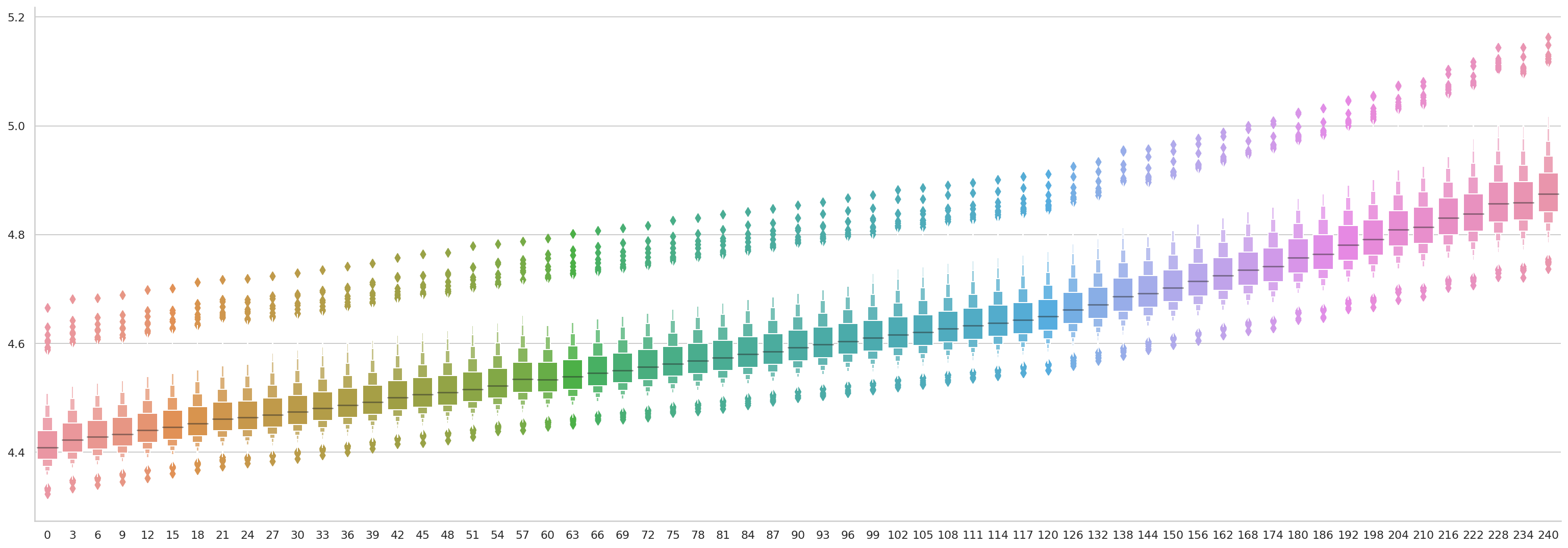
统计趋势
使用 Seaborn 绘制线性回归示意图。
单个时次
线性拟合单个时次,选择 6 个数据作为代表。
d = df.loc[pd.date_range("2020-04-10", "2020-04-15", freq="D")].T
d = d.apply(lambda x: x/pd.Timedelta(hours=1))
d["forecast_hour"] = d.index
d = d.melt(id_vars="forecast_hour")
d["variable"] = d["variable"].apply(lambda x: x.strftime("%Y-%m-%d"))
d.head()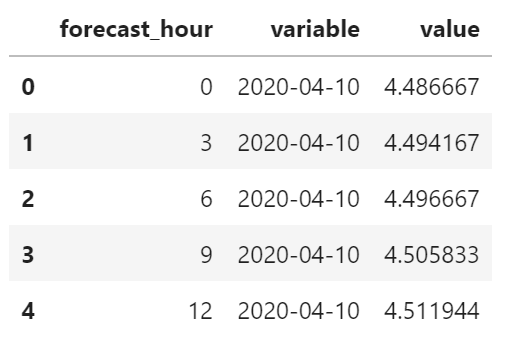
为每个时次绘制线性回归
ax = sns.lmplot(
x="forecast_hour",
y="value",
hue="variable",
data=d,
)
ax.fig.set_size_inches(12, 8)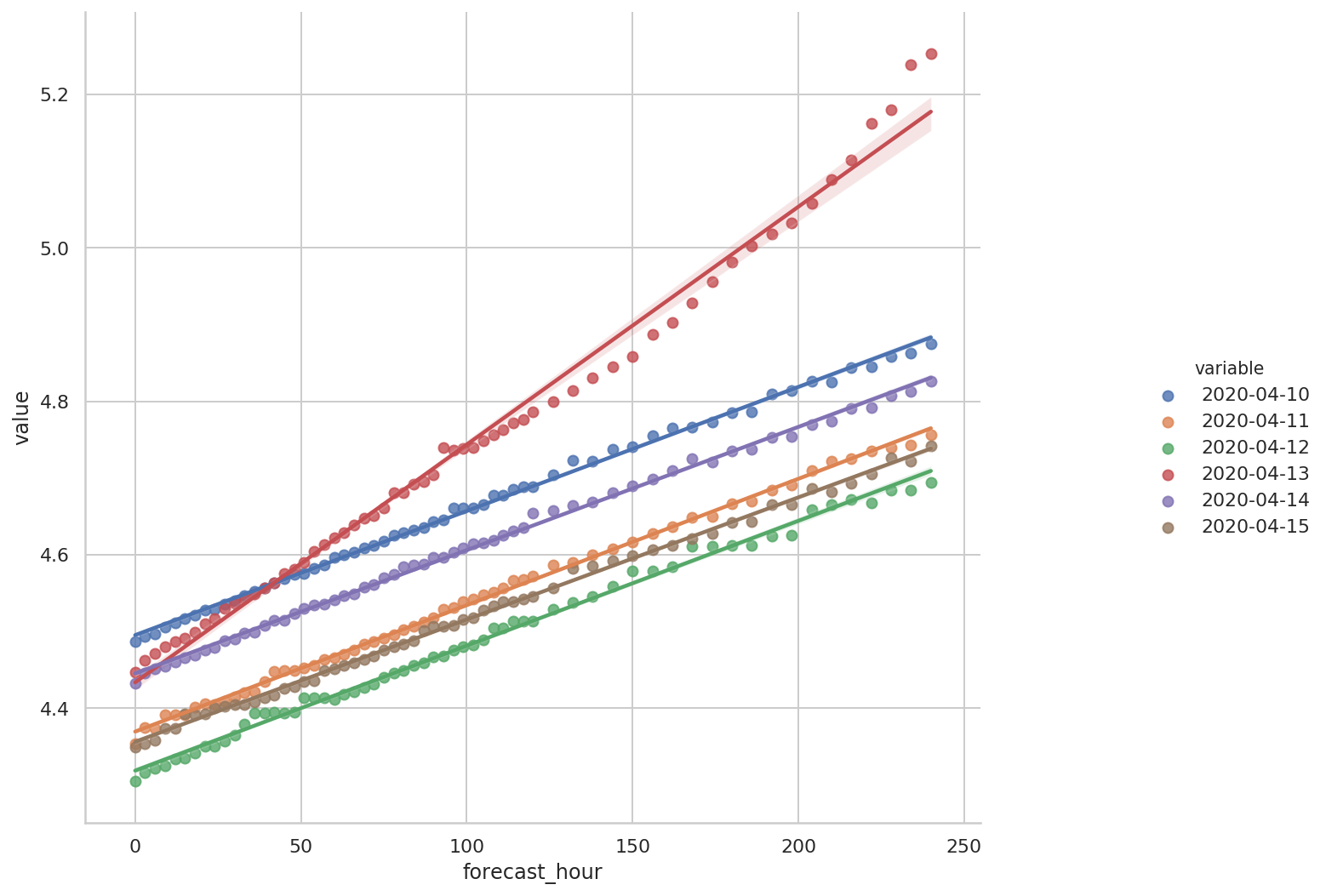
可以看到除了 4 月 13 日的红色线外,其余 5 条趋势线斜率基本一致。
从《统计数值预报产品生成时间:单个时效重采样》中的图形可以看到,4 月 13 日的 240 时效产品属于“延迟”类型,而其余 5 天均正常。
所有结果
线性拟合所有结果
df2 = df.T
df2["forecast_hour"] = df2.index
df3 = df2.melt(id_vars="forecast_hour")
df3["value"] = df3["value"]/pd.Timedelta(hours=1)
f, ax = plt.subplots(figsize=(15, 10))
sns.regplot(
x="forecast_hour",
y="value",
data=df3,
ax=ax,
)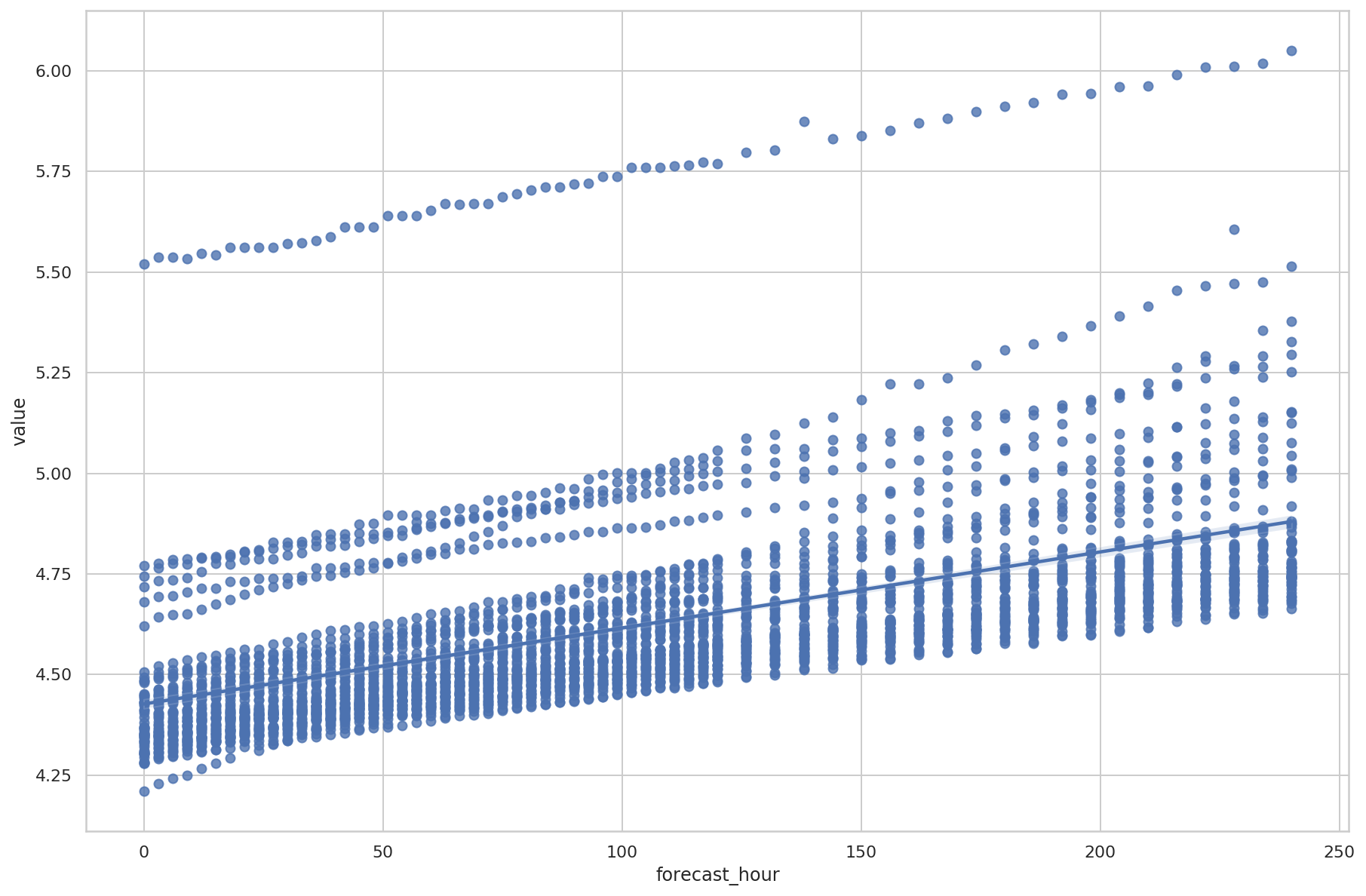
线性拟合重采样的数据
df2 = bdf.T
df2["forecast_hour"] = df2.index
df3 = df2.melt(id_vars="forecast_hour")
df3["value"] = df3["value"]/pd.Timedelta(hours=1)
ax = sns.lmplot(
x="forecast_hour",
y="value",
data=df3,
)
ax.fig.set_size_inches(15, 10)
重采样后的数据趋势基本一致。
